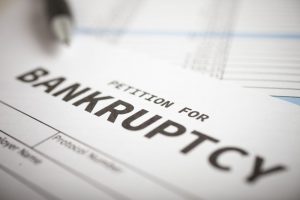A Commercial Eviction is a delicate topic and typically the last item a landlord wants to deal with. In most cases evicting a commercial tenant or business is a last resort and is usually due to nonpayment of rent. It is a tough decision to make because a tenant’s business can be destroyed upon eviction. But your own rental business income and profitability are at stake if you don’t evict, so the decision is easier to make.
Under California law, landlords of commercial properties can demand that non-paying tenants pay the past due rent and still proceed with an eviction process if tenants do not pay the rent in full amount of the past due rent, or in other words, they pay a partial amount towards their balance. Acceptance of partial payment does not mean a commercial landlord is waiving his right to file an Unlawful Detainer to get a tenant removed. If the tenant pays the rent in full, though, the eviction is off.

Commercial landlords must first give notice to non-paying problem tenants that accepting partial payment is not a waiver of a landlord’s intent to regain possession of their property and force a tenant out. And if a delinquent tenant pays part of the rent, the commercial landlord’s attorney is not required to inform the court and may amend the complaint to conform to proof at trial giving the new total due in writing on his own without the court’s permission.
Commercial evictions by 3-Day Notice to Quit or Non-payment of Rent in the California Code of Civil Procedure (CCP) §1161.1 allows the landlord to prepare a document called “an estimated rent demand.” The landlord can estimate the amount of rent due when, for various reasons, the exact amount is not known. The 3-Day Notice (or Five Day whatever length of time the lease specifies) must clearly state the “reasonable estimated” amount of rent due.
The landlord can continue to accept rent after the 3-Day Notice is served on the tenant. It is important to note that notices to quit or pay rent can be designated in the lease for longer duration than three days. Notices can be five days, ten days, thirty days, etc. The time period is an important point because if the tenant fails to pay rent within the period in the notice, they can be evicted and lose their business.
Commercial Unlawful Detainer
The type of lawsuit that the landlord brings if the tenant fails to pay rent, damages the property or fails otherwise to live up to the lease is called an “unlawful detainer.” Unlawful detainer hearings or trials generally take place within a short time after the tenant is served with the Notice to Quit or Pay Rent. Unlawful Detainer Lawsuits are given priority over all other civil cases within the court system. California law provides for a speedy resolution in landlord-tenant disputes.
If a tenant receives a Notice to Pay Rent or Quit or Notice to Quit, some of them move out rather than go through the legal process of trying to continue in possession of the property. If the tenant does not move out (or pay the rent in full), then the landlord proceeds with the unlawful detainer lawsuit that will be filed in court. Sometimes tenants stay and fight it out in court because to close their business would ruin it. They take a chance that the court will order the landlord to let them stay there, however, that is not likely in a non-payment of rent situation.
If the landlord serves a 3-Day Notice with a reasonable estimate of the amount of rent due and the tenant doesn’t pay the full amount of rent due, if the judge determines the lesser to be what is owed, then the tenant is “the prevailing party” or the winner of the lawsuit. This is important because most commercial leases include a prevailing party clause that says the prevailing party collects attorney fees from the other party. If the landlord loses at trial, he must pay the tenant’s attorney fees and allow the tenant to continue using his property.
What is Considered a Commercial Property

Commercial property in California is described by state law as any type of property that does not have dwellings on it. Under this definition, even a parking lot or an empty lot is commercial property.
However, if your property is configured, the laws are different for commercial property leases. Commercial tenants do not have as much protection because it is assumed they are more knowledgeable, experienced and have the money to hire experts like attorneys and engineers.
Estimate the Rent – plus or minus 20 percent
The law allows landlords in Commercial Properties to estimate the amount of back rent the landlord is due, and it will be deemed reasonable if it is within 20 percent of the actual amount due as determined in court at trial.
This means a tenant can be made to pay more than what he actually owes. For example, if the tenant’s usual rent is $1,000 and the landlord demands 20 percent more, $1,200, the court can still rule for the landlord. A tenant could pay the $1,200 when he receives the notice or just pay $1,000 and hope the judge finds in his favor when the matter goes to court. The $1,000 initially would be considered partial payment, but the judge could deem it the amount due at the unlawful detainer hearing. (These figures are just examples; your rents may be different.) Please keep in mind, that the plus or minus is not a loophole for a landlord to take advantage of by simply overstating the Notice to Pay Rent by 20 percent. This provision is usually used on commercial shopping malls where the rent is a base amount, like $5,000.00 per month plus 4% of the gross sales of the business. In these instances, if the landlord doesn’t know the amount of the rent because the tenant hasn’t disclosed the sales to the landlord, then the landlord can estimate. If you have a commercial property for a fixed amount, like 2,500.00 per month, then there is no need to estimate the rent.
Commercial tenants may desperately need to keep leasing the property or their business would fail. If they don’t pay it in full, their business and their livelihood might go bankrupt.
What If a Commercial tenant files for bankruptcy

If the landlord receives notice that the tenant has filed for bankruptcy after the landlord sends the tenant a notice to quit or pay rent, the unlawful detainer suit is automatically stayed pursuant to Federal Bankruptcy law. The landlord can file a motion in Bankruptcy Court asking the court for relief from the automatic stay. If the judge grants the motion, the Unlawful Detainer action can continue but the court will only allow you to get a Judgment for Possession of the property. In general, the court will not allow you to get a money judgment or collect money from the tenant unless it is approved by the court.
Noise complaints from adjacent property
If a tenant complains to you, the landlord, that a nearby neighbor is making too much noise, this is something you should attempt to rectify. Tenants have a right to reasonable peace and quiet called a “right to quiet enjoyment.” If you determine one of your tenants is making too much noise, take action to stop it. You might even have to evict the noise making tenant. Keep in mind, that many commercial properties are in industrial areas and noise isn’t an issue.
Commercial Tenant Security Deposit
When a commercial tenant moves out after the lease expires, landlords are not required to send a security deposit disposition form under California law unless it is written into the lease.
California Civil Code 1950.7 governs commercial security deposits. If all the tenant owes is back rent, the landlord is allowed 30 days to return the unused part of the deposit. If the deposit exceeds one month’s rent, the extra amount above it must be returned within two weeks of the tenant vacating. The remainder should be returned or accounted for within 30 days of the landlord getting possession of the rental property.
If the landlord must deduct past due rent, repairs, or costs for cleaning and repairing the facility, he has up to 30 days to return the unused amount of the deposit.
In a commercial lease, these terms can be modified and stated with different time frames to suit the landlord and tenant. They can write the terms and conditions of the security deposit clause as they see fit.
Commercial Property Tenant Withholds Rent
A tenant is not allowed to withhold payment of rent for a reason such as dead plants outside his storefront or any other reason. The covenant that requires the tenant to pay the rent on time each month is independent of other covenants in the lease agreement. The tenant can sue for damages, but the law does not allow him to withhold payment of rent. If the tenant stops paying rent, you can serve him notice of eviction. And as stated, commercial tenants do not have as much protection under the laws of California, and it is easier to evict them than other types of tenants.
If the tenant moves out and leaves stuff behind

You must post and send the former tenant a document called a Notice of Right to Reclaim Personal Property listing the former tenant’s belongings. If 18 days pass without any word from the tenant, California law says you may dispose of the property yourself if you reasonably believe its worth is up to $750 or $1 per square foot of rental property. If it is worth more than that, you should sell the stuff at auction.
The tenant signed but didn’t move in
The safest way to go if a tenant signs the lease but doesn’t move in is to file for eviction and go through that legal process as opposed to filing a Notice of Abandonment of Real Property. If you believe the tenant won’t return and he doesn’t pay the rent for at least two weeks, the landlord can serve a Notice of Abandonment, wait 18 days and then take possession of the property. But if the tenant does return and all you have is the Notice of Abandonment, he may be allowed to re-enter the property because you do not have a legal judgment that specifies eviction.
Tenant is evicted with years remaining on lease
If you evict a tenant who has time still left on the lease, you can file a separate lawsuit and obtain a judgment to receive the rent due, but you must also try to find another tenant to sublet the rental property to. You are required by law to mitigate your damages which means, try and rent the property to another commercial tenant and then sue for the amount of money that you lost as a result of the tenants breach of the lease.
Payment plan after eviction
If you want to come to an agreement for a payment plan, your attorney can write up a stipulation with the terms and conditions that is enforced by the court. If the tenant defaults on the payments, you do not have to refile for eviction. Your attorney can write up the paperwork for a judgment and a sheriff lockout.
Verbal agreements to increase rent
You and your tenant can initially agree verbally to increase the rent, but you should spell it out in an amended lease document or an addendum and both of you should sign it. Our attorneys at Express Evictions can draw up an addendum to your lease for you.

Names on the Notice to Pay Rent
When serving a notice to pay rent, we are sometimes asked if the notice must include the name of a person, and not just a management company. It is wise to include the name of a person. Some courts have ruled that the part of California law that says the notice must include “the amount which is due, the name, telephone number, and address of the person to whom the rent shall be made” means a specific person must be named, not a company. We advise you to include at least one person’s name and the name of the management company on the rent notice. That way the person named may accept rent from the tenant.
Who Pays Taxes, Insurance, Utilities, Upkeep
There are many ways that a Commercial Lease Agreement can be drawn, In Commercial Lease Agreements, rents are sometime based on the sales revenue of the tenant, the property taxes may or may not be paid by the landlord, there is Common Area Maintenance (CAM) charges, there can be extra charges to the tenant for use on nights or weekends.
The lease agreement should clearly identify who pays the property taxes, utilities and upkeep of the premises. You can also specify who pays for utility bills. Under California law, landlords and tenants can work these charges out, however, it must be in writing. If there are multiple tenants in a shopping center, for example, the amounts due are prorated based on percentage of lease square footage. If there are two tenants, and one tenant has 400 square feet and another 600 square feet, the charges would be prorated at 40 percent and 60 percent. These leases where the tenant pays everything, such as, rent, utilities, property taxes, insurance, etc. are termed NNN leases, or triple net leases for the three main categories: taxes, insurance and upkeep or maintenance. If the lease contract does not have these terms, it called a commercial or industrial gross lease.
We Can Help
We have helped dozens of landlords with Commercial Evictions. For professional assistance with an eviction, don’t hesitate to contact us today.





